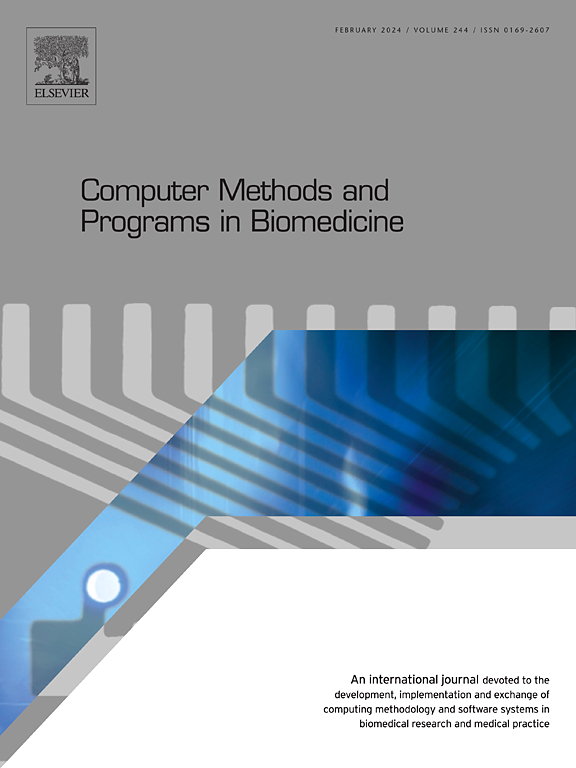Real-time ultrasound shear wave elastography using a local phase gradient
IF 4.9
2区 医学
Q1 COMPUTER SCIENCE, INTERDISCIPLINARY APPLICATIONS
引用次数: 0
Abstract
Background and Objective:
Current approaches for ultrasound spectral elastography make use of block processing, resulting in long computational times. This work describes a real-time, robust, and quantitative imaging modality to map the elastic and viscoelastic properties of soft tissues using ultrasound.
Methods:
This elastographic technique relies on the spectral estimation of the shear-wave phase speed by combining a local phase-gradient method and angular filtering. We first apply directional filtering in the spatio-temporal frequency domain for providing one-way, smooth, and harmonic displacement maps in the frequency range of interest. Thanks to this, we can apply a simple, fast, and local phase gradient approach to obtain the axial and lateral components of the wavevector, which are linked to phase velocity and soft-tissue elasticity and viscoelasticity. The technique is validated numerically and experimentally using a 7.6 MHz ultrasound probe, tested in calibrated soft-tissue phantoms and ex vivo liver tissues. The method is compared with state-of-the-art spectral methods.
Results:
The technique significantly reduces the computation time, e.g., the reconstruction time for a 155 × 315-pixel phase-velocity map was 0.16 s, while local-phase velocity-imaging techniques was 156.73 s for 2D implementation and 13.56 s for the 1D version, a reduction between two and three orders of magnitude, while showing a similar accuracy and resolution than standard methods.
Conclusions:
This approach eliminates the need for block processing that may limit the spatial resolution and computational time of the velocity map. In this way, the phase gradient elastography method is revealed as an efficient and robust approach for real-time spectral elastography.

利用局部相位梯度的实时超声剪切波弹性成像。
背景和目的:目前的超声光谱弹性成像方法使用块处理,导致计算时间长。这项工作描述了一种实时的、鲁棒的、定量的成像模式,利用超声波来绘制软组织的弹性和粘弹性特性。方法:采用局部相位梯度法和角滤波相结合的方法对剪切波相速度进行谱估计。我们首先在时空频域中应用定向滤波,在感兴趣的频率范围内提供单向、平滑和谐波位移图。因此,我们可以应用一种简单、快速和局部相位梯度的方法来获得波矢量的轴向和横向分量,这些分量与相速度、软组织弹性和粘弹性有关。使用7.6 MHz超声探头对该技术进行了数值验证和实验验证,并在校准的软组织模型和离体肝组织中进行了测试。该方法与最先进的光谱方法进行了比较。结果:该技术显著缩短了计算时间,155 × 315像素相速度图的重建时间为0.16 s,而局部相速度成像技术的二维重建时间为156.73 s,一维重建时间为13.56 s,减少了2到3个数量级,同时显示出与标准方法相似的精度和分辨率。结论:该方法消除了可能限制速度图空间分辨率和计算时间的块处理需要。这表明相位梯度弹性成像方法是一种高效、鲁棒的实时光谱弹性成像方法。
本文章由计算机程序翻译,如有差异,请以英文原文为准。
求助全文
约1分钟内获得全文
求助全文
来源期刊

Computer methods and programs in biomedicine
工程技术-工程:生物医学
CiteScore
12.30
自引率
6.60%
发文量
601
审稿时长
135 days
期刊介绍:
To encourage the development of formal computing methods, and their application in biomedical research and medical practice, by illustration of fundamental principles in biomedical informatics research; to stimulate basic research into application software design; to report the state of research of biomedical information processing projects; to report new computer methodologies applied in biomedical areas; the eventual distribution of demonstrable software to avoid duplication of effort; to provide a forum for discussion and improvement of existing software; to optimize contact between national organizations and regional user groups by promoting an international exchange of information on formal methods, standards and software in biomedicine.
Computer Methods and Programs in Biomedicine covers computing methodology and software systems derived from computing science for implementation in all aspects of biomedical research and medical practice. It is designed to serve: biochemists; biologists; geneticists; immunologists; neuroscientists; pharmacologists; toxicologists; clinicians; epidemiologists; psychiatrists; psychologists; cardiologists; chemists; (radio)physicists; computer scientists; programmers and systems analysts; biomedical, clinical, electrical and other engineers; teachers of medical informatics and users of educational software.
 求助内容:
求助内容: 应助结果提醒方式:
应助结果提醒方式:


